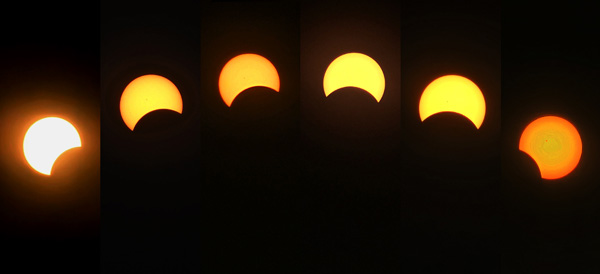A total solar eclipse covers the American sky

[A partial solar eclipse was observed in California on April 8th. Photo Credit: Yujun Lee]
A total solar eclipse passed by the mainland United States on April 8th, 2024.
It was a total solar eclipse that was observed in the mainland United States in 7 years, following the total solar eclipse that happened on August 21st, 2017.
Starting from the Pacific Ocean, the solar eclipse passed Mexico, the United States, and Canada, and it ended in the Atlantic Ocean.
When a total solar eclipse happens, the Moon casts two types of shadows on Earth as it passes between the Sun and the Earth: the umbra and the penumbra.
The umbra is the part of the shadow where the sunlight is completely blocked, while the penumbra is the part that surrounds the umbra, where the sunlight is partially blocked, yet not completely.
Because two types of shadow appear during total solar eclipses, only the areas where an umbra cast experiences a total solar eclipse, and areas where a penumbra cast only experiences a partial solar eclipse.
The path of the umbra during a total solar eclipse is called the “path of totality.”
In this total solar eclipse, the path of totality crossed Mexico and passed parts of 13 US states, from Texas up to Maine, where it continued further in the northeast direction.
It was 2:27 p.m. Eastern Time when the totality began in Texas, and it was 3:35 p.m. Eastern Time when it ended in Maine.
The duration of totality at the middle of the path of totality was about 4 minutes, with the longest recorded duration being 4 minutes and 28 seconds, near Torreón, Mexico.
While the totality was only observed in 13 states, all 48 states in the mainland United States experienced a partial solar eclipse, along with the state of Hawaii and a small portion of Alaska.
The proportion of the Sun that the Moon covered during the partial solar eclipse depended on the location’s distance to the path of totality.
According to Time and Date AS, a maximum of about 48.9% of the Sun was covered in Los Angeles, and a maximum of about 89.9% of the Sun was covered in New York City.
Many Americans went outside to observe the solar eclipse, and some went to the areas under the path of totality, despite it happening on a Monday.
While a total eclipse is uncommon, it is dangerous to stare at it with bare eyes.
Staring at a solar eclipse can cause “solar retinopathy,” where even a short duration of exposure to the eclipse can burn the retina in the eyes, which might lead to serious vision loss that can be permanent.
Because of this, it is necessary to wear eclipse glasses, which are specialized glasses used to watch solar eclipses.
Eclipse glasses filter most lights, and only strong lights such as the sunlight can be seen through its lenses.
Americans will have to wait about 20 years to see another total solar eclipse.
The next totality in the mainland United States will happen on August 22nd, 2044, which will be observed in Montana, North Dakota, and South Dakota.
The one after that will happen on August 12th, 2045, which will be observed in 15 states, from northern California to Florida.

- Yujun Lee / Grade 10
- Homestead High School

![THE HERALD STUDENT REPORTERS [US]](/assets/images/logo_student_us.png)
![THE HERALD STUDENT REPORTERS [Canada]](/assets/images/logo_student_ca.png)
